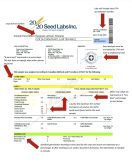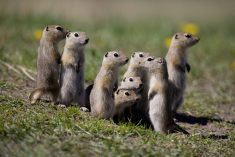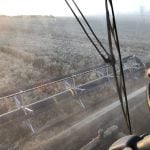Forage seed production may not receive the attention of many other parts of the beef industry, but it plays a crucial role.
Nathan Siklenka and his father, Darrel Siklenka, own and operate Siklenka Seed Farm together near Glaslyn, Sask. The farm has been in operation since 1985.
Siklenka Seed Farm is well known for its production of a variety of forage seeds. Darrel says producing a quality product is the most important thing to them as forage seed producers.
Read Also

The Canadian Cattle Association’s international advocacy efforts
Global ag policies affect Canadian food policy, so the Canadian Cattle Association participates in international and domestic forums
“You’re as close to being weed-free as possible,” he says. “So stuff isn’t getting spread around the country, as we have to live here and plan on living here for a long time. And we don’t need our name turning into mud. So I guess that’s the reason we started, is to supply a good product to our local neighbours. And it just continued from there.”
Nathan operated a beef ranch for a long time, as well. However, he doesn’t have his own herd anymore, but does custom grazing and produces hay for customers.
“We took what seemed like the easy money, then. It’s definitely got its pros and cons. Cons this year, I don’t own the cows when the price is good,” Nathan says with a laugh.
Challenges
Canada is a world leader in forage seed production. However, most production occurs in the Peace region of Alberta and British Columbia.
In Saskatchewan, forage seeds have been grown and produced for over a hundred years, and the province produces a fair amount of forage. Manitoba also produces forages, resulting in around 100,000 acres.
The Siklenkas believe the most challenging part of producing forages is also the most important part — keeping fields clean.
“The less weeds you have, the better your production, the better your yield is. Doesn’t matter whether it’s for seed or for hay or pasture,” Darrel says.
“We’ve got to have fields clean to start with. That’s one of the big things. When Roundup came in there, it was supposed to be such a good thing — that we wouldn’t have any weeds left. And it definitely helps with some stuff. But you still unfortunately have to till the soil to get rid of some weeds.”
Dry conditions across parts of the Prairies have been a challenge over the past few years for the forage industry, as it has been for many other agricultural industries and producers. Drought stresses forage crops and leaves them susceptible to pests, and with many places going into their fourth year of drought since 2020, it has become a major concern.
Popular forages
Darrel and Nathan say, currently, cicer milkvetch is popular with producers.
“It used to be something that nobody really wanted to deal with. I think part of that is just a generational thing,” Nathan says.
He says 15 years ago many producers were older farmers who didn’t want to commit to a forage that would take five or 10 years to get going.
“Most of those guys were looking at us like we were crazy because they figured they weren’t going to live long enough to see it,” Nathan says.
“The next generation, they’re somewhat younger individuals and they’re seeing the positives, whether it’s in a neighbour’s field or somewhere else.”
Siklenka Seed Farm sees a lot of interest in cicer milkvetch, as seen at the Saskatchewan Forage Council’s 2023 Pasture Tour, where Nathan led a group through their field of cicer milkvetch and answered the many questions producers and industry professionals had.
Darrel says alfalfa remains a favourite. But lately producers have been moving away from hybrid alfalfa varieties.
“The hybrid will give them a better yield for the first couple of years, but they wind up winter killing. And then all of a sudden that puts them in between a rock and a hard spot, that they’ve gotten no alfalfa coming up. So, they’ve been going to older varieties again.”
Establishment
The Siklenkas say one of the most common questions producers ask is regarding establishment. Nathan says it’s hard to advise on how to establish a forage crop because it depends on the farmer and their field.
“Typically, we’re giving advice to individual farms depending on where they are, what soil they’re in, as far as varieties, or which species of crop to be utilizing.”
Overall, his advice is to make sure their field is clean.
Darrel suggests seeding forages with a nurse crop to keep the weeds down. If a producer seeds a nurse crop with the forage in May, “they can wind up baling the hay after they have a killing frost. And they can get three or four bales for the acre.”
Darrel and Nathan agree that a forage variety’s establishment and performance will depend on where they live and their management practices.
“For new people putting in grasses for the first time or legumes for the first time, talk to a neighbour to see what has worked in their particular area. Because all soil conditions are different, and we know what grows well in our soil conditions,” Darrel says.
“You can variate a little bit, but Mother Nature has kind of given you the indications as to what’s growing in your area and doing well.”
Forage market
Though forage seeds are an important commodity, used by many livestock producers in Canada and across the world, it’s not a growing industry. According to the 2021 data of inspected fields from Peace Forage Seed, the seed acres for Canadian pedigreed grass and legumes are declining and have been for a few years. 2021 saw the lowest inspected acres since 2007.
“Unfortunately, there’s less cows around all the time,” Darrel says.
Nathan says their operation won’t be expanding anytime soon. With just two of them working on the farm, they’re limited for labour. The market also has its challenges.
“It’s a cyclical market. So if we put the whole farm into grass seed, there would be feast and famine, depending on where we are,” he says.
However, despite the industry challenges, the Siklenkas remain steadfast.
“We believe in quality seed,” Darrel says.

















